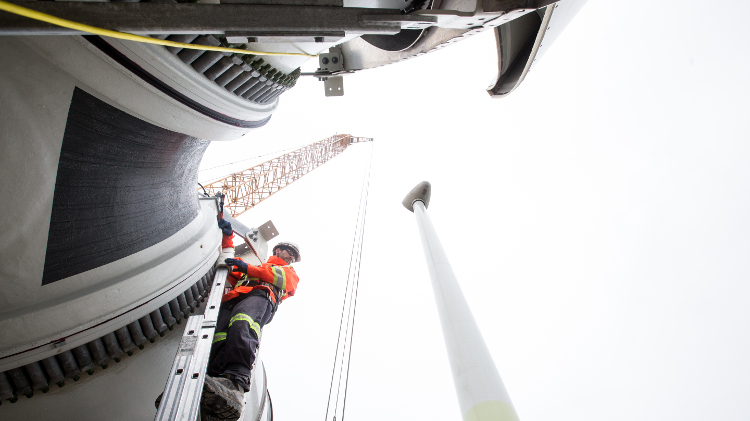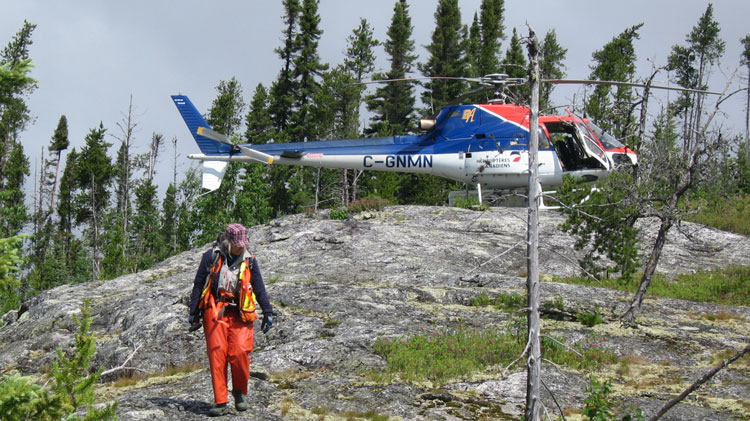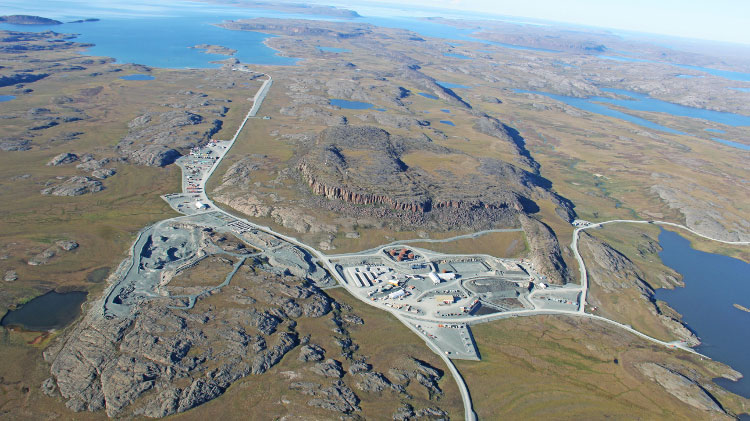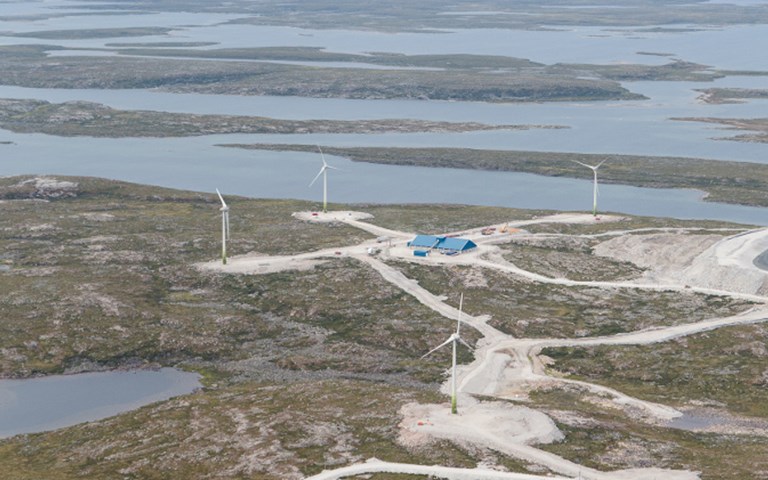Four 2.3-megawatt wind turbines now feed power to the Diavik mine northeast of Yellowknife. Courtesy of Diavik
In 2006, a warmer than average winter meant the ice road to Rio Tinto’s Diavik operation opened late, closed early, and never reached its full load capacity, leaving millions of litres of fuel essential to powering the operation stranded in Yellowknife, N.W.T. The company had no choice but to fly it in at a steep cost.
With Diavik relying on the eight- to 10-week ice road window to truck in all of its fuel for the year, the episode opened management’s eyes to the looming threat of climate risk, and the even larger impact it could have on operations as the mine transitioned from open pit to more energy-intensive underground mining. As a result, reducing its diesel requirements – and the risk of uncontrollable supply seasons – became a priority.
This job fell to Liezl Van Wyk, Diavik’s principal energy advisor and current business improvement manager. As she describes the project from her office at the mine, Van Wyk’s eyes immediately betray an intensity and passion, without which the four, 64-metre tall, 2.3-megawatt (MW) turbines may never have begun turning out power on the Arctic tundra on time and under budget.
Initially, Diavik considered many options to supplement its power usage, including building hundreds of kilometres of transmission lines to a hydroelectric dam, solar, geothermal and even modular nuclear power. “We really put everything out there and ran with all of them until they started cancelling out,” says Van Wyk. “Wind was the one that had the biggest economic return.”
Diavik collected three years of wind monitoring data that showed it had a viable wind resource. Van Wyk drew up a $33-million budget, with the aim to generate roughly 10 per cent of Diavik’s annual power usage – 17 gigawatt hours (GWh) of its required 180 GWh – through wind power. In 2011, the project was approved by Rio Tinto brass and the real work began.
Van Wyk and two wind resource consultants from Genivar walked the mine site and found the current wind farm location, where buildings and structures did not restrict the wind. To select a turbine type, Van Wyk interviewed manufacturers and introduced them to the project, the risks and the North’s frigid operating conditions.
Ultimately, Van Wyk chose the Germany-based Enercon’s E-70 direct-drive design which has no gearbox. By avoiding a gearbox, she explains, “you take out the single biggest component that tends to fail.” The design also has the benefits of being a lower-RPM machine – meaning much less friction – and quieter than gearbox turbines.
Long road home
Parts were shipped from Germany to Thunder Bay, Ontario, and then trucked up to Yellowknife. The final leg of the journey proved most difficult. A 373-kilometre winter road snakes up to Diavik from Yellowknife, over dozens of ice roads and land portages.
Van Wyk says the ice road portions were easy, since they are straight and flat. The challenges were the portages. “The portage has a very quick inclination and you need to go around trees and rocks, so you have very short turning radiuses. You’ve got a 35-metre long blade and it’s fiberglass, epoxy-resin impregnated material, which is very fragile and there were no spares available,” she explains. Operating in a remote area, under strict project timelines, meant any damaged materials would delay construction and affect the economics of the project.
Enercon working with Equipment Express modified the trailers to provide additional clearance, and to support the long turbine components, and EBA Engineering redesigned the road with a 35-metre turning radius in mind. Road builder Nuna Logistics constructed ice ramps onto portages to decrease many portage inclines. “From 64 challenging portages, we ended up with four that were really tricky,” says Van Wyk. The turbine parts arrived in roughly 60 truckloads during the 2012 winter road season. The 6.5-tonne turbine blades are the longest loads ever trucked up the winter road.
Road construction and foundation prep work started in the fall of 2011. The first of the four tower foundations, each roughly 20 metres in diameter, three metres thick and requiring 20-hour continuous concrete pours, was poured June 12, 2012. Each tower pad contains 300 cubic metres of concrete and 20 kilometres of rebar. Tower construction began in July. “The tower came in three sections and there were a total of six lifts for each tower,” says Gord Stephenson, project engineer with the mine’s capital projects department, adding each turbine went up in about one week. The turbines were linked up to Diavik’s power grid and, following commissioning, the wind farm provided power to the mine on September 28.
Hybrid power
Integrating the turbines with the power grid has added a new element to powerhouse control room operators’ jobs. Since wind is not constant, the energy created can fluctuate. But Diavik uses all of the wind power generated.
Each facility, including underground, processing plant, batch plant and accommodations, has a unique energy use profile, but when they are combined, they become relatively stable. From summer to winter, the overall load can be anywhere from 19 MW to 26 MW. In comparison, Yellowknife – a city of 19,000 – uses an average of roughly 25 MW, according to Nikolaus Auerboeck, mine technical services manager.
Diavik constructed a second powerhouse to build capacity for its underground operations and now has 11 Caterpillar diesel generators in total – nine 4.4-megawatt generators and two 3.3-megawatt generators. “But we never run everything at once,” says Auerboeck. Diavik also has four 1.2-megawatt backups at its disposal from its construction phase.
If the power draw is 25 MW, control room operators manually build a power supply profile using a combination of the diesel generators that, along with the wind power generated, add up to that number. “It’s like building Lego,” says Van Wyk. Any capacity from the generators above the mine’s power draw is called the spinning reserve, which is what the control room operators can tap into if the wind drops off. “You’ve got capacity online, but you’re not using it,” says Van Wyk.
Each generator has its own efficiency curve. “You want to run it between 70 and 100 per cent,” Van Wyk explains. “We tend to run them at 85 per cent to 90 per cent. It doesn’t cost us unless we operate on the lower part of the efficiency curve, but again, it’s choosing which generator [to turn off] so we can run the right combination.” She says they shut down generators depending on wind farm production. “Let’s say (the wind farm is producing) 3.2 MW – which is a good day – it means I have offset one generator here. I can switch it off.”
Bill Felgate, a powerhouse control room operator for nine years at Diavik, enjoys the new challenge. “You’ve kind of got to learn to balance the bigger load shifts, the changes in wind and the diesel generation,” he says. Control room operators monitor the mine’s power draw, each generator’s energy output and each wind turbine’s output in real time on a large screen. “I couldn’t say how often we’re looking at it, but how often are you looking at the rear-view mirror in your car? You’re always looking at it, but you don’t realize it.”
Diavik uses a wind-forecasting model that predicts wind speeds three hours in advance. Performance is improving as operators gain more experience with the hybrid system and begin to feel comfortable adjusting the power loads on the fly. “They are starting to take more risk,” says Van Wyk.
 Construction on the project began in the fall of 2011 and the power first began flowing in September 2012. Courtesy of Diavik
Construction on the project began in the fall of 2011 and the power first began flowing in September 2012. Courtesy of Diavik
Operators also anticipate surges in energy pulls at the mine, like when underground water pumps start up, and they fire up generators accordingly. The diesel generators take roughly three minutes to start, and once running, can operate at 105 to 110 per cent efficiency for a short time to make up for power surges. “If something happens, if there’s a quick spike, your system won’t go down,” says Felgate. “Most of the time, we try to keep the spinning reserve around two megawatts or so.”
Volatile winds
Just like diesel generators, the turbines have their own efficiency curves. A wind of five metres per second (m/s) generates roughly 125 kilowatts, but a wind of 10 m/s generates 1.23 MW. Auerboeck says the curve starts to flatten out at around 12 m/s. Once the wind reaches 15 m/s and more, power is stable at 2.3 MW and there is very little change, even if the wind jumps to 25 m/s. Collectively, the four turbines were designed to produce a maximum of 9.2 MW, but can actually generate 9.4 MW under ideal conditions.
Van Wyk can pull up the wind power output numbers on her desktop computer and shows the range of wind power generation from the previous week. “From nine megawatts, really quickly it dropped down to three megawatts,” she points out. “It lost six megawatts [in five minutes.] If you’re not awake as a control room operator, you can quickly be short six megawatts. You’ve got to watch it.”
This is why the wind farm was conceived to provide only a fraction of the mines’ power needs. “If you went with 80 or 90 per cent wind, it would be very hard to control,” says Auerboeck.
Winter blues
The wind farm had a difficult first winter – the region’s coldest in 30 years. “We lost two months in December and January because of very cold weather, and they were still learning the system,” says Van Wyk. The team learned the circuit breakers inside the turbines were too small, and the lubrication used could not withstand such low temperatures. There were problems with the turbine blade heaters. Diavik also learned how many spares to have on site and how to respond when the whole turbine went down. “When it is down, it doesn’t have the ability to generate heat and then everything goes south, especially electronics,” says Van Wyk. “These were all very important [findings.]”
The team installed heaters inside the towers to keep the electronic components warm. And Felgate adds many of the small bugs and trips Diavik has encountered are normal for the first year and a half of such a system.
“[The turbines] are operational to -40 degrees C by design,” says Van Wyk. “To truly prove it, I think we’ll have to wait until the upcoming season.”
Wind does work
Despite these problems, Diavik might still meet its 17-gigawatt-hour target in the first year. On July 22, the four turbines had generated nearly 11.8 GWh since October 2012, even with the winter downtime. “So it’s two months of kilowatt hours lost,” says Van Wyk. “I am now curious to see if it’s catching up. So far, it looks like it, unless something else happens.”
The project came in at $31 million, roughly $2 million under budget and, according to communications advisor Doug Ashbury, the wind farm has offset about 2.5 million litres of diesel so far. While Diavik targeted the wind project to provide around 10 per cent of its energy requirements, at one point in July, the installation was generating 52 per cent of the mine’s power.
“It also helps us from a risk point of view,” says Auerboeck, adding the project will run until the end of the mine life – currently 2023. The project will eliminate about 100 fuel truckloads annually and has a payback period of around eight years. “When fuel prices get higher, of course, then that reduces the payback time of the project,” adds Auerboeck.
The project is also proving that wind power is viable in the cold, remote North, where diesel is a major expense for residents, communities and governments. Diavik recently donated its wind monitoring tower to a local First Nation to gather data on the wind resource near the Giant mine site in Yellowknife, with the hopes that it could power the mine’s reclamation work. “The biggest winner of this could be the government of the Northwest Territories because we’re taking the risk to prove this can work,” says David Wells, Diavik’s environment superintendent. “If it does work – and it’s working so far – there’s no reason that we can’t be putting this into small communities.”





